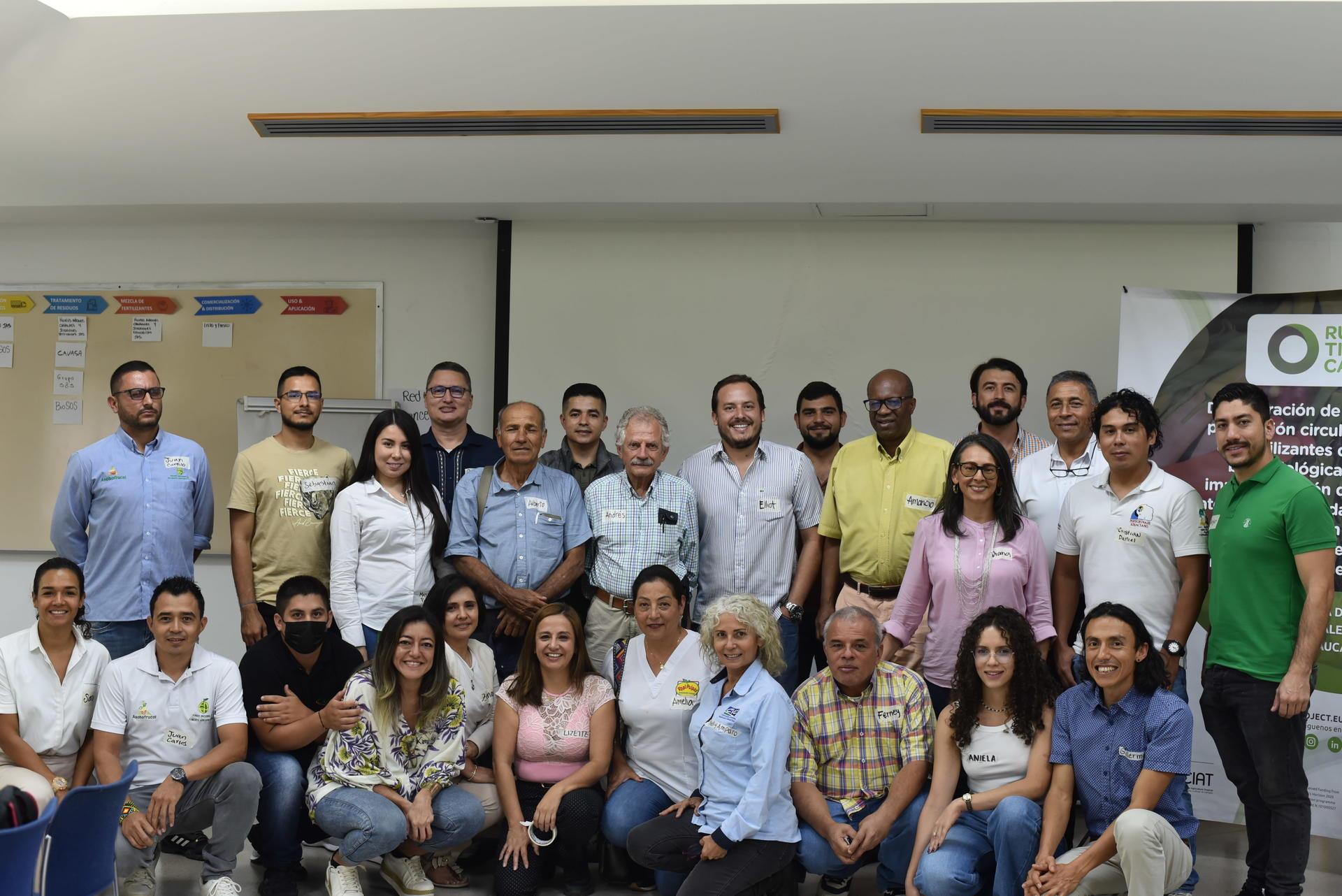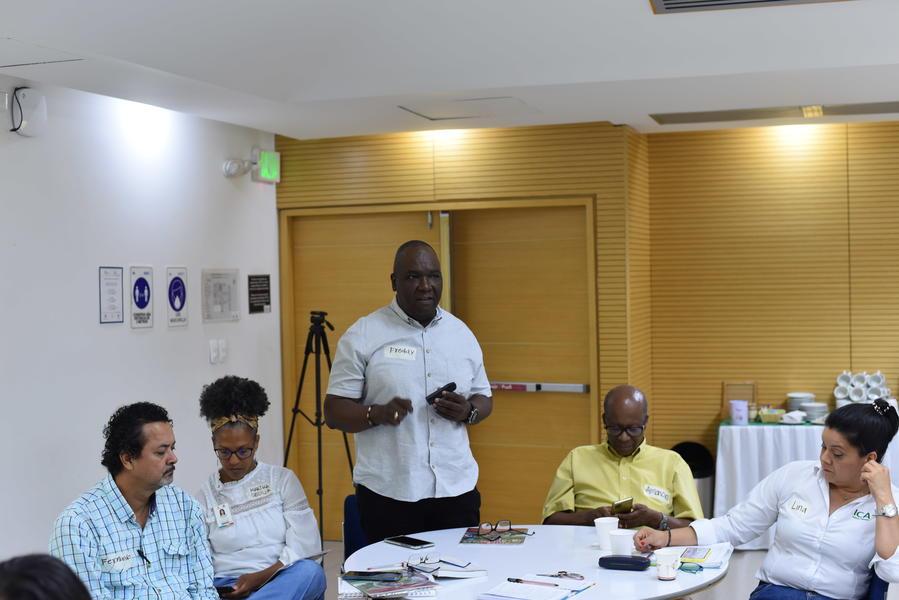From the Field Cultivating sustainability: RUSTICA promotes the creation of the organic fertilizer chain in the Cauca Valley

By: Sara Rankin, Guillermo Peña, Lizette Díaz
.
During its fourth regional workshop, the RUSTICA project promotes the formalization of the first organic fertilizer chain in Valle del Cauca together with the multi-stakeholder platform made up of support entities for the primary sector, waste treatment plants for fertilizer production, collection operators, and agents generating usable waste; food distribution channels, industries and agricultural producers. The interaction of the actors under a chain approach creates synergies and increases the prospects for common success.
Since 2021, the RUSTICA project initiated a participatory exercise with regional stakeholders involved in the manufacture and use of organic fertilizers, creating a multi-stakeholder platform that seeks to: 1. Debate about the valorization of agri-food waste for use in agriculture; 2. Share global research results; 3. Discuss how these studies can be translated into guidelines and knowledge applicable in our region; and 4. Strengthen local knowledge.
At present, this platform of actors includes the participation of entities that support the primary sector, waste treatment plants for the production of fertilizers, collection operators, and agents that generate usable waste; among them, food distribution channels, industries and agricultural producers.
Since this network of stakeholders must include representatives of agricultural chains of economic relevance to the department, we made sure to include the chains prioritized in the departmental agricultural extension plan, in addition to the associations representing pork, poultry and fruit and vegetable production.
During the process of identifying key stakeholders, we identified the key actors who would be involved in the development of the network. During the process of identifying key actors and organizations that are part of the department's organic fertilizer ecosystem, the need to create synergies among the chain's agents to address common challenges and evaluate opportunities became evident. For this reason, in the last project workshop we worked on the conformation of the organic fertilizer chain in Valle del Cauca. The interaction of actors under a chain approach improves the prospects for common success and maximizes their impact. It also fosters collaboration among the links and is a great opportunity for strengthening initiatives in this productive sector so that they are not disjointed from public and private projects. This was expressed by one of the platform's participants:
"The participation of different actors allows this chain to have a global and complete vision of the process and, in turn, allows the interaction between these private alliances and the public regulatory part to bear special fruit for this type of policy" Luis Amancio Arias, Colombian Agricultural Institute-ICA Valle del Cauca sectional.



For the above reasons, from the beginning of the project we have sought to institutionalize the multi-stakeholder space and have the advice of the public sector, especially the Ministry of Agriculture and Rural Development MinAgriculture and the Government of Valle del Cauca, through the Secretary of Rural Development, Agriculture and Fisheries in charge of promoting the chain spaces, and the Secretary of Environment and Sustainable Development, which leads the construction of the departmental agroecology plan.
During the participatory exercise, it was necessary to think about how to direct joint efforts and promote the integration of new actors. For the case of chain organizations in the agricultural sector, the guidelines granted by Law 811 of 2003 facilitate this planning process, which results in the concerted formulation of strategies and the definition of action plans to improve collective and individual economic performance. This guide can be complemented with the guidelines of strategic planning to define a shared long-term vision, determine objectives and propose actions for the competitive development of a value chain that emerges to contribute to the sustainability of regional agriculture.
This first workshop on the creation of the chain was the perfect opportunity to contextualize the importance of strategic planning, to learn about the regulatory framework for agrochains, and to review existing gaps or limitations from the perspective of those involved and interacting in the chain. To cite an example of the problems identified, the following is what was shared by the representative of a fruit processing industry: The following is an example of the problems identified.
"For us, as a fruit processing company, the main problem we have in the chain is that we need to improve the use of the waste generated or by-products of the process. At the moment we do not have the support for good management and we have to knock on many doors causing the cost of the product to rise a lot" Zenayda Hernandez, Pulpi Fresh
All members of the project's regional stakeholder platform are key players in the development of bio-based fertilizer production initiatives in the region. We hope that once the chain is consolidated, new proposals and business models will continue to emerge that will enhance the capacities and opportunities for the production, market and use of organic fertilizers. In this way, we are confident that this seed planted by RUSTICA will allow us to continue cultivating sustainability in the Colombian countryside, and to pursue purposes such as those expressed by one of the actors of our network:
.
"What are we looking for today with this space: 1. To be able to share ideas, strategies, that allow us in the framework of a bio-input chain to articulate all the actors that allow us to reduce the gaps that exist; 2. That from a field use of organic waste our producers in Valle del Cauca can have access to inputs so that they have a more sustainable production over time; 3. Reduce the environmental impact generated by by-products through industries, the food supply chain and marketplaces; and 4. That we can connect this exercise to improve the circular economy around food production and waste disposal" Juan Carlos Valencia, Asociación Hortifrutícola de Colombia-Asohofrucol Valle del Cauca
.
